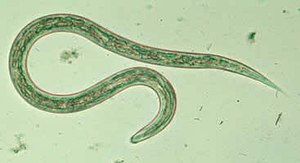Hookworms
| Hookworms | ||||||||||||
|---|---|---|---|---|---|---|---|---|---|---|---|---|

Free-living larva of the hookworm Ancylostoma duodenale |
||||||||||||
| Systematics | ||||||||||||
|
||||||||||||
| Scientific name | ||||||||||||
| Ancylostomatidae | ||||||||||||
| Looss , 1905 |
The hookworms (Ancylostomatidae) are a family of roundworms (nematodes). Two of its species are pathogenic to humans ( Necator americanus and Ancylostoma duodenale ). Both species occur as parasites and have no intermediate host . Hookworm infestation is called ankylostomiasis or hookworm disease (formerly Dubini disease ).
distribution
They are among the most common causes of worm infections in the tropics and subtropics. It affects 900 million people, of whom up to 60,000 die each year from the infection. Necator americanus (English hookworm ) is widespread in the tropics , whereas Ancylostoma duodenale is mostly found in the subtropics . The third larvae found in the environment are very susceptible to drought and direct sunlight. It occurs primarily among the rural population in the tropics and subtropics and mostly affects children and smallholders who defecate near the fields or where manure is used. In the past there were infections with Ancylostoma duodenale among miners in coal mining in Central Europe , as there is enough moisture and the right temperature there. It was therefore called a pitworm. This species, which also occurs in Italy, was discovered during the construction of the Gotthard tunnel (construction began in 1872) in Switzerland , but was first described by Angelo Dubini in 1843.
features
The worms have a round cross-section. The females are up to one centimeter long, the males only slightly shorter.
Life cycle
The hookworm goes through seven stages in its development. In addition to the worm, which reproduces sexually and lays eggs , there are five successive larval stages.
The worm itself resides in the intestine , where the female lays the eggs. These are excreted into the environment with the excrement . This is where the first larva hatches and feeds on bacteria in the feces . A second larva then emerges from this.
The later developing third larva actively migrates into the soil , where it settles in the top layer and waits for a suitable host .
When skin contact with the people , usually on the feet , it pierces and sheds its skin, this creates a fourth larva, it enters the blood into the lungs . It sheds its skin again to the fifth larva. It is transported from the lungs to the bronchi , where it is coughed up and then swallowed. After swallowing, it settles in the intestine and sheds its skin for the last time and becomes a fully-grown worm. The worms and the fifth larva suck blood on the villi .
Symptoms
Anemia caused by the blood loss (Egyptian or Ethiopian chlorosis) and extensive destruction of the intestinal villi can cause abdominal pain, whereby adult worms can ingest 20 to 30 microliters of blood per day. Tension, fatigue, unconsciousness, depression and apathy occur. Heart failure and death can occur. Children mainly die from blood loss.
therapy
Hookworms can be treated with mebendazole , albendazole or pyrantel in tablet form. A stool examination should be carried out after six weeks to check the success of the treatment. Hookworm vaccines are under development.
swell
- ↑ Lars Bluma: The hookworm on the Ruhr. Environment, body and social networks in the mining of the Kaiserreich, in: Der Anschnitt, 61, 2009, H. 5–6, P. 314–329.
- ^ Gotthard tunnel and Ancylostoma .
- ↑ Angelo Dubini: Nuovo avoid intestinale umano (Agchylostoma duodenale), costituente un sesto genere dei Nematoidei proprii dell'uomo. In: Annali universali di medicina Volume 106, (Milan) 1843, pp. 5-13.
- ↑ Barbara I. Tshisuaka: Dubini, Angelo. In: Werner E. Gerabek , Bernhard D. Haage, Gundolf Keil , Wolfgang Wegner (eds.): Enzyklopädie Medizingeschichte. De Gruyter, Berlin / New York 2005, ISBN 3-11-015714-4 , p. 324.
- ↑ Horst Kremling : On the development of clinical diagnostics. In: Würzburger medical history reports 23, 2004, pp. 233–261; here: p. 249.
- ↑ Schubert-Zsilavecz, Manfred., Roth, Hermann J .: Medicinal Chemistry: Targets - Drugs - Chemical Biology; 191 tables . 2., completely reworked. and exp. Ed. Dt. Apotheker-Verl, Stuttgart 2010, ISBN 978-3-7692-5002-2 .
- ^ Marianne Abele-Horn: Antimicrobial Therapy. Decision support for the treatment and prophylaxis of infectious diseases. With the collaboration of Werner Heinz, Hartwig Klinker, Johann Schurz and August Stich, 2nd, revised and expanded edition. Peter Wiehl, Marburg 2009, ISBN 978-3-927219-14-4 , p. 289.